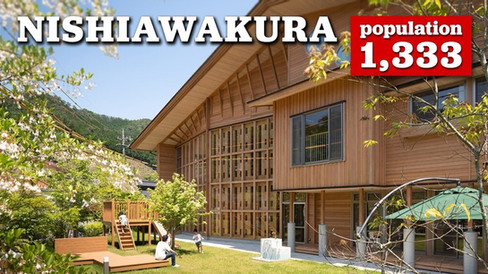Nishiawakura: The Japanese village reborn through its forest
- Román Hernández
- Jul 29
- 2 min read
As urbanization rapidly expands worldwide, some rural communities prove living in harmony with nature is possible without giving up modern progress. One such example is Nishiawakura, a small village in Japan’s Okayama Prefecture that has gained recognition for its commitment to sustainable and regenerative living.
The transformation began in 2008, when local authorities launched an ambitious initiative known as the 100-Year Forest Vision. Faced with a shrinking and aging population, the village crafted this strategy in collaboration with forestry experts and rural development planners. The goal? To revitalize the local economy by sustainably managing the forest that covers 95% of its land.

Since then, Nishiawakura has become a magnet for designers, architects, and citizens seeking a more conscious and regenerative way of life.
Fostering Artistic Exchange in Harmony with Nature
In May 2025, Nishi Awakura Village became the backdrop for a unique cultural gathering: the CI (Contact Improvisation) Camp titled “Mind • Mass • Motion.” Held from May 2nd to 5th at Awakura Kaikan and Hyakumori Hiroba, this immersive residential workshop was led by renowned dance artists Charlie Morrissey and Kirstie Simson, following their participation in the Tokyo Contact Improvisation Festival.
The CI Camp marked a turning point in positioning Nishiawakura as more than a site of sustainable design; it’s also becoming a cultural node that blends ecological living with creative expression. Events like this reflect the village’s growing dedication to holistic revitalization, bridging rural life with contemporary arts.
Participatory Governance: A Community That Thrives
Regeneration in Nishiawakura goes even further. The village has developed a participatory governance model where residents collectively decide on new initiatives. This bottom-up approach has strengthened community ties and attracted newcomers seeking a simpler, more collaborative, and ecologically integrated lifestyle.
Photo courtesy: Hiromi Charles
A standout example of this openness is the artist residency program developed in partnership with Shelburne Craft School in Vermont, USA. The program fosters cultural exchange and hands on learning through sustainable craft practices in the heart of rural Japan.
Fascinating Facts: The Beauty of Small-Scale Living
Since the project’s inception, Nishiawakura has welcomed over 200 new residents, many of whom are young professionals and creatives seeking a slower, more intentional life.
The Japan Times awarded Nishiawakura the Excellence in Sustainability Prize in
2021 for its innovative forestry approach and community-led development.
Toward a Global Vision of Regenerative Architecture
Nishiawakura is a powerful example of how rural spaces can be reimagined to meet modern challenges. Its success lies in its eco-friendly buildings and its strong social fabric, capacity to foster self-reliance, and ability to draw people who value a slower, more sustainable pace of life.
Photo courtesy: Hiromi Charles
From architecture to governance, this Japanese village is now an international reference for regenerative design, rural innovation, and climate resilience.
Want to Explore More Projects Like This?
At The Greener Space, we spotlight the projects transforming architecture, design, and community living through a regenerative lens. Explore more stories like this on our website and follow us on social media to stay informed about the innovations shaping a more sustainable future.
Sources:
















